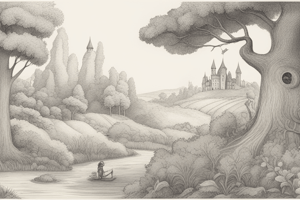Podcast
Questions and Answers
What is the primary function of the alveoli in the respiratory system?
What is the primary function of the alveoli in the respiratory system?
- To produce sounds for vocalization
- To conduct air to the trachea
- To filter out pathogens from the air
- To facilitate gas exchange (correct)
Which structures are primarily involved in the protection of the respiratory system?
Which structures are primarily involved in the protection of the respiratory system?
- Cilia and mucus (correct)
- Pharynx and larynx
- Lungs and diaphragm
- Alveoli and bronchi
During inhalation, what happens to the diaphragm and intercostal muscles?
During inhalation, what happens to the diaphragm and intercostal muscles?
- They contract and increase thoracic cavity volume (correct)
- They relax and decrease thoracic cavity volume
- They contract and decrease thoracic cavity volume
- They relax and increase thoracic cavity volume
What role does the medulla oblongata play in the respiratory system?
What role does the medulla oblongata play in the respiratory system?
Which respiratory disorder is characterized by airflow limitations due to chronic bronchitis and emphysema?
Which respiratory disorder is characterized by airflow limitations due to chronic bronchitis and emphysema?
What is the primary function of the respiratory system concerning blood pH?
What is the primary function of the respiratory system concerning blood pH?
What constitutes the main passageway for air before it reaches the larynx?
What constitutes the main passageway for air before it reaches the larynx?
Which of the following actions occurs during exhalation?
Which of the following actions occurs during exhalation?
How do the bronchi function in the respiratory system?
How do the bronchi function in the respiratory system?
What is a common characteristic of asthma?
What is a common characteristic of asthma?
Flashcards are hidden until you start studying
Study Notes
Overview of the Respiratory System
- The respiratory system is responsible for gas exchange, supplying oxygen, and removing carbon dioxide from the body.
- Major structures include the nose, pharynx, larynx, trachea, bronchi, lungs, and alveoli.
Main Functions
- Gas Exchange: Oxygen enters the blood, and carbon dioxide is expelled.
- Regulation of Blood pH: Maintains acid-base balance through carbon dioxide control.
- Protection: Filters out pathogens and particulates via mucus and cilia.
- Vocalization: Produces sound through the larynx.
Anatomy
- Nose: Filters, warms, and humidifies air.
- Pharynx: Passageway for air and food; connects nasal cavity and larynx.
- Larynx: Contains vocal cords; regulates airflow.
- Trachea: Windpipe; connects larynx to bronchi; lined with cilia and mucus.
- Bronchi: Two main branches that lead to each lung; further divide into bronchioles.
- Lungs: Main organs of respiration; contain alveoli for gas exchange.
- Alveoli: Tiny air sacs where oxygen and carbon dioxide exchange occurs.
Breathing Process
- Inhalation: Diaphragm and intercostal muscles contract, expanding the thoracic cavity and drawing air in.
- Exhalation: Muscles relax, thoracic cavity decreases, and air is pushed out.
Regulation of Breathing
- Controlled by the respiratory center in the brainstem (medulla oblongata and pons).
- Responds to changes in blood CO2 and O2 levels, as well as pH.
Common Respiratory Disorders
- Asthma: Chronic condition causing inflammation and narrowing of airways.
- Chronic Obstructive Pulmonary Disease (COPD): Includes chronic bronchitis and emphysema; characterized by airflow limitation.
- Pneumonia: Infection causing inflammation of alveoli, leading to fluid accumulation.
- Tuberculosis (TB): Bacterial infection primarily affecting the lungs.
Importance of Respiratory Health
- Essential for overall health; influences energy levels, physical performance, and immune function.
- Smoking, pollution, and allergens can significantly impair respiratory function.
Overview of the Respiratory System
- Responsible for gas exchange, oxygen supply, and carbon dioxide removal.
- Key structures include the nose, pharynx, larynx, trachea, bronchi, lungs, and alveoli.
Main Functions
- Gas Exchange: Oxygen is absorbed into the bloodstream while carbon dioxide is released.
- Regulation of Blood pH: Maintains acid-base balance by controlling carbon dioxide levels.
- Protection Mechanism: Filters pathogens and particles through mucus and cilia in the airways.
- Vocalization: Sound production occurs in the larynx.
Anatomy
- Nose: Cools, warms, and humidifies inhaled air; serves as an entry point for air.
- Pharynx: Connects nasal cavity to larynx; serves as a pathway for both air and food.
- Larynx: Houses vocal cords; regulates airflow during breathing and sound production.
- Trachea: Also known as the windpipe, it connects the larynx to bronchi; lined with cilia and mucus for filtering.
- Bronchi: Primary branches from the trachea leading into the lungs; subdivide into smaller bronchioles.
- Lungs: Main organs for respiration that house alveoli for efficient gas exchange.
- Alveoli: Microscopic air sacs where oxygen and carbon dioxide exchange occurs.
Breathing Process
- Inhalation: Diaphragm and intercostal muscles contract, expanding the thoracic cavity and drawing air into the lungs.
- Exhalation: Relaxation of muscles reduces the thoracic cavity, forcing air out of the lungs.
Regulation of Breathing
- Managed by the respiratory center located in the brainstem (medulla oblongata and pons).
- Adjusts breathing rate in response to fluctuations in blood CO2, O2, and pH levels.
Common Respiratory Disorders
- Asthma: Characterized by chronic inflammation and narrowing of airways, causing difficulty in breathing.
- Chronic Obstructive Pulmonary Disease (COPD): Includes chronic bronchitis and emphysema; results in airflow limitations.
- Pneumonia: Infection leading to inflammation of the alveoli and fluid accumulation in the lungs.
- Tuberculosis (TB): A contagious bacterial infection primarily targeting the lungs, causing severe coughing and chest pain.
Importance of Respiratory Health
- Vital for overall health, directly affecting energy levels, physical performance, and immune efficiency.
- Environmental factors such as smoking, pollution, and allergens can severely compromise respiratory health.
Studying That Suits You
Use AI to generate personalized quizzes and flashcards to suit your learning preferences.




